Services
Introoduction
Section titled “Introoduction”Although the microservices driven architecture aims to decouple the components of an application, microservices still need agents to logically tie or group them together for management purposes, or to load balance traffic to the ones that are part of such a logical set.
In this chapter, we will learn about Service objects used to abstract the communication between cluster internal microservices, or with the external world. A Service offers a single DNS entry for a stateless containerized application managed by the Kubernetes cluster, regardless of the number of its replicas, by providing a common load balancing access point to a set of pods logically grouped and managed by a controller such as a Deployment, ReplicaSet, or DaemonSet.
We will also learn about the kube-proxy daemon, which runs on each control plane and worker node to implement the services’ configuration and to provide access to services. In addition we will discuss service discovery and service types, which decide the access scope of a service.
Accessing Application Pods
Section titled “Accessing Application Pods”To access the application, a user or another application needs to connect to a Pod running the target application. As Pods are ephemeral in nature, resources like IP addresses allocated to them cannot be static. Pods could be terminated abruptly or be rescheduled based on existing requirements.
Let’s take, for example, a scenario where an operator manages a set of Pods and a user/client is accessing the Pods directly by using their individual IP addresses. This access method requires the client to retrieve the target Pods’ IP addresses in advance, introducing an unnecessary overhead for the client.
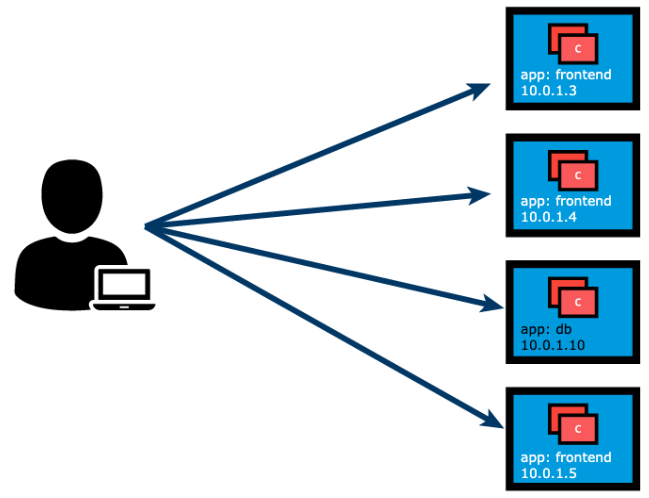
Unexpectedly, one of the Pods the user/client is accessing is terminated, and a new Pod is created by the controller. The new Pod will be assigned a new IP address that will not be immediately known by the user/client. If the client tries to watch the target Pods’ IP addresses for any changes and updates, this will result in an inefficient approach that will only increase the client’s overhead.
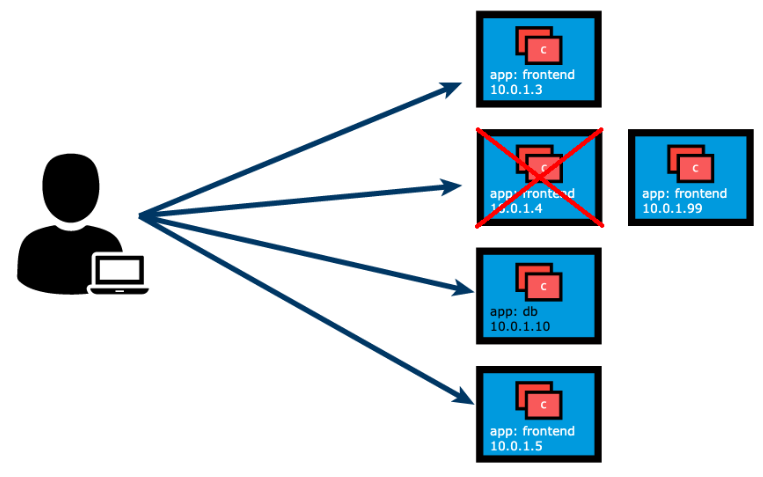
To overcome this situation, Kubernetes provides a higher-level abstraction called Service, which logically groups Pods and defines a policy to access them. This grouping is achieved via Labels and Selectors. This logical grouping strategy is used by Pod controllers, such as ReplicaSets, Deployments, and even DaemonSets. Below is a Deployment definition manifest for the frontend app, to aid with the correlation of Labels, Selectors, and port values between the Deployment controller, its Pod replicas, and the Service definition manifest presented in an upcoming section.
apiVersion: apps/v1kind: Deploymentmetadata: labels: app: frontend name: frontendspec: replicas: 3 selector: matchLabels: app: frontend template: metadata: labels: app: frontend spec: containers: - image: frontend-application name: frontend-application ports: - containerPort: 5000Services
Section titled “Services”Labels and Selectors use a key-value pair format. In the following graphical representation, app is the Label key, frontend and db are Label values for different Pods.

Using the selectors app==frontend and app==db, we group Pods into two logical sets: one set with 3 Pods, and one set with a single Pod.
We assign a name to the logical grouping, referred to as a Service. The Service name is also registered with the cluster’s internal DNS service. In our example, we create two Services, frontend-svc, and db-svc, and they have the app==frontend and the app==db Selectors, respectively.
Services can expose single Pods, ReplicaSets, Deployments, DaemonSets, and StatefulSets. When exposing the Pods managed by an operator, the Service’s Selector may use the same label(s) as the operator. A clear benefit of a Service is that it watches application Pods for any changes in count and their respective IP addresses while automatically updating the list of corresponding endpoints. Even for a single-replica application, run by a single Pod, the Service is beneficial during self-healing (replacement of a failed Pod) as it immediately directs traffic to the newly deployed healthy Pod.
Service Object Example
Section titled “Service Object Example”The following is an example of a Service object definition. This represents the declarative method to define an object, and can serve as a template for a much more complex Service definition manifest if desired. By omitting the Service type from the definition manifest, we create the default service type, the ClusterIP type (the ClusterIP Service type will be covered in an upcoming lesson).
apiVersion: v1kind: Servicemetadata: name: frontend-svcspec: selector: app: frontend ports: - protocol: TCP port: 80 targetPort: 5000The above definition manifest, if stored by a frontend-svc.yaml file, is loaded into the cluster to set up the necessary routes and rules to send traffic to the Pod replicas of the earlier defined frontend Deployment. While create is exemplified below, advanced Kubernetes practitioners may opt to use apply instead:
kubectl create -f frontend-svc.yamlImperatively, we can use a direct method to expose the Deploymen’s Pods.
kubectl expose deploy frontend --name=frontend-svc --port=80 --target-port=5000The expose command parses the referenced Deployment object to extract valuable pairing details such as Name, Label, Selector, and containerPort to populate these values in the Service object. However, especially in cases when the Service port and Service targetPort values are expected to be distinct (80 and 5000 respectively), it is best to explicitly supply these values with the expose command. In addition, we decided to change the name of the Service with the name option (the default behavior is for the Service object to inherit the exposed Deployment’s name frontend).
Another imperative method to set up the same Service from above is through the create service command. The rather complex command below first sets up a frontend Service with frontend Label and frontend Selector in dry-run mode, it updates the Service name to frontend-svc and then loads the definition in the cluster.
kubectl create service clusterip frontend \--tcp=80:5000 --dry-run=client -o yaml \| sed 's/name: frontend/name: frontend-svc/g' \| kubectl apply -f -In this example, we are creating a frontend-svc Service by selecting all the Pods that have the Label key=app set to value=frontend. By default, each Service receives an IP address routable only inside the cluster, known as ClusterIP. In our example, we have 172.17.0.4 and 172.17.0.5 as ClusterIPs assigned to our frontend-svc and db-svc Services, respectively.
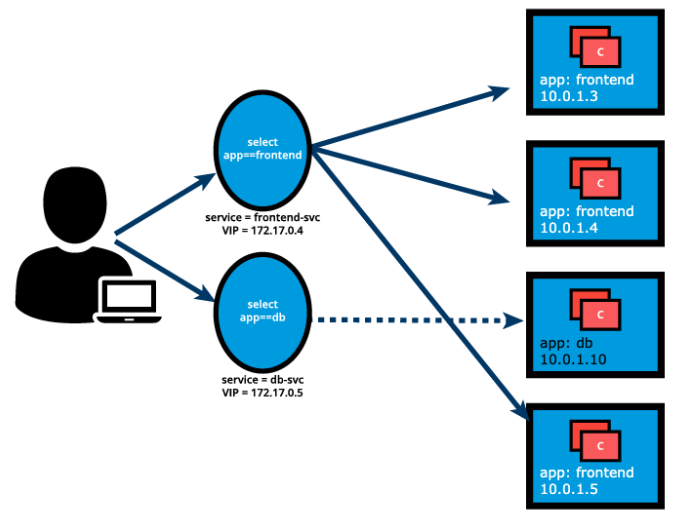
The user/client now connects to a Service via its ClusterIP, which forwards traffic to one of the Pods attached to it. A Service provides load balancing by default while selecting the Pods for traffic forwarding.
While the Service forwards traffic to Pods, we can select the targetPort on the Pod which receives the traffic. In our example, the frontend-svc Service receives requests from the user/client on port: 80 and then forwards these requests to one of the attached Pods on the targetPort: 5000. If the targetPort is not defined explicitly, then traffic will be forwarded to Pods on the port on which the Service receives traffic - in this case the targetPort implicitly is assigned the value of the port. It is very important to ensure that the value of the targetPort, which is 5000 in this example, matches the value of the containerPort property of the Pod spec section.
A logical set of a Pod’s IP address, along with the targetPort is referred to as a Service endpoint. In our example, the frontend-svc Service has 3 endpoints: 10.0.1.3:5000, 10.0.1.4:5000, and 10.0.1.5:5000 respectively. Endpoints are created and managed automatically by the Service, not by the Kubernetes cluster administrators or developers.
The Service and associated endpoints can be listed with:
kubectl get service,endpoints frontend-svckubectl get svc,ep frontend-svckube-proxy
Section titled “kube-proxy”Each cluster node runs a daemon called kube-proxy, a node agent that watches the API server on the control plane node for the addition, updates, and removal of Services and endpoints. kube-proxy is responsible for implementing the Service configuration on behalf of an administrator or developer, in order to enable traffic routing to an exposed application running in Pods. In the example below, for each new Service, on each node, kube-proxy configures iptables rules to capture the traffic for its ClusterIP and forwards it to one of the Service’s endpoints. Therefore any node can receive the external traffic and then route it internally in the cluster based on the iptables rules. When the Service is removed, kube-proxy removes the corresponding iptables rules on all nodes as well.
Just as the kube-proxy node agent runs redundantly on each cluster node, the iptables are populated in a redundant fashion by their respective node agents so that each iptables instance stores complete routing rules for the entire cluster. This helps with the Service objects implementation to reproduce a distributed load balancing mechanism.
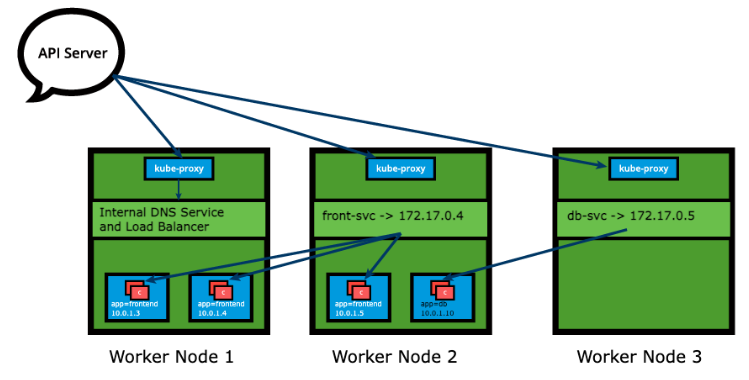
Traffic Policies
Section titled “Traffic Policies”The kube-proxy node agent together with the iptables implement the load-balancing mechanism of the Service when traffic is being routed to the application Endpoints. Due to restricting characteristics of the iptables this load-balancing is random by default. This means that the Endpoint Pod to receive the request forwarded by the Service will be randomly selected out of many replicas. This mechanism does not guarantee that the selected receiving Pod is the closest or even on the same node as the requester, therefore not the most efficient mechanism. Since this is the iptables supported load-balancing mechanism, if we desire better outcomes, we would need to take advantage of traffic policies.
Traffic policies allow users to instruct the kube-proxy on the context of the traffic routing. The two options are Cluster and Local:
-
The Cluster option allows kube-proxy to target all ready Endpoints of the Service in the load-balancing process. This is the default behavior of the Service even when the traffic policy property is not explicitly declared.
-
The Local option, however, isolates the load-balancing process to only include the Endpoints of the Service located on the same node as the requester Pod, or perhaps the node that captured inbound external traffic on its NodePort (the NodePort Service type will be covered in an upcoming lesson). While this sounds like an ideal option, it does have a shortcoming - if the Service does not have a ready Endpoint on the node where the requester Pod is running, the Service will not route the request to Endpoints on other nodes to satisfy the request because it will be dropped by kube-proxy.
Both the Cluster and Local options are available for requests generated internally from within the cluster, or externally from applications and clients running outside the cluster. The Service definition manifest below defines both internal and external Local traffic policies. Both are optional settings, and can be used independent of each other, where one can be defined without the other (either internal or external policy).
apiVersion: v1kind: Servicemetadata: name: frontend-svcspec: selector: app: frontend ports: - protocol: TCP port: 80 targetPort: 5000 internalTrafficPolicy: Local externalTrafficPolicy: LocalService Discovery
Section titled “Service Discovery”As Services are the primary mode of communication between containerized applications managed by Kubernetes, it is helpful to be able to discover them at runtime. Kubernetes supports two methods for discovering Services:
Environment Variables
Section titled “Environment Variables”As soon as the Pod starts on any worker node, the kubelet daemon running on that node adds a set of environment variables in the Pod for all active Services. For example, if we have an active Service called redis-master, which exposes port 6379, and its ClusterIP is 172.17.0.6, then, on a newly created Pod, we can see the following environment variables:
REDIS_MASTER_SERVICE_HOST=172.17.0.6REDIS_MASTER_SERVICE_PORT=6379REDIS_MASTER_PORT=tcp://172.17.0.6:6379REDIS_MASTER_PORT_6379_TCP=tcp://172.17.0.6:6379REDIS_MASTER_PORT_6379_TCP_PROTO=tcpREDIS_MASTER_PORT_6379_TCP_PORT=6379REDIS_MASTER_PORT_6379_TCP_ADDR=172.17.0.6With this solution, we need to be careful while ordering our Services, as the Pods will not have the environment variables set for Services which are created after the Pods are created.
Kubernetes has an add-on for DNS, which creates a DNS record for each Service and its format is my-svc.my-namespace.svc.cluster.local. Services within the same Namespace find other Services just by their names. If we add a Service redis-master in my-ns Namespace, all Pods in the same my-ns Namespace lookup the Service just by its name, redis-master. Pods from other Namespaces, such as test-ns, lookup the same Service by adding the respective Namespace as a suffix, such as redis-master.my-ns or providing the FQDN of the service as redis-master.my-ns.svc.cluster.local.
This is the most common and highly recommended solution. For example, in the previous section’s image, we have seen that an internal DNS is configured, which maps our Services frontend-svc and db-svc to 172.17.0.4 and 172.17.0.5 IP addresses respectively.
If we had a client application accessing the frontend application, the client would only need to “know” the frontend application’s Service name and port, which are frontend-svc and port 80 respectively. From a client application Pod we could possibly run the following command, allowing for the cluster internal name resolution and the kube-proxy to guide the client’s request to a frontend Pod:
kubectl exec client-app-pod-name -c client-container-name -- /bin/sh -c curl -s frontend-svc:80ServiceType
Section titled “ServiceType”While defining a Service, we can also choose its access scope. We can decide whether the Service:
- Is only accessible within the cluster.
- Is accessible from within the cluster and the external world.
- Maps to an entity which resides either inside or outside the cluster.
Access scope is decided by ServiceType property, defined when creating the Service.
ClusterIP and NodePort
Section titled “ClusterIP and NodePort”ClusterIP is the default ServiceType. A Service receives a Virtual IP address, known as its ClusterIP. This Virtual IP address is used for communicating with the Service and is accessible only from within the cluster. The frontend-svc Service definition manifest now includes an explicit type for ClusterIP. If omitted, the default ClusterIP service type is set up:
apiVersion: v1kind: Servicemetadata: name: frontend-svcspec: selector: app: frontend ports: - protocol: TCP port: 80 targetPort: 5000 type: ClusterIPWith the NodePort ServiceType, in addition to a ClusterIP, a high-port, dynamically picked from the default range 30000-32767, is mapped to the respective Service, from all the worker nodes. For example, if the mapped NodePort is 32233 for the service frontend-svc, then, if we connect to any worker node on port 32233, the node would redirect all the traffic to the assigned ClusterIP - 172.17.0.4. If we prefer a specific high-port number instead, then we can assign that high-port number to the NodePort from the default range when creating the Service.
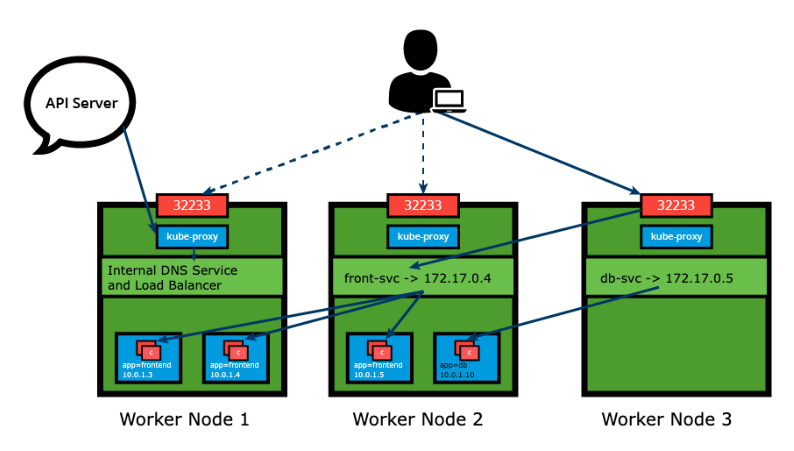
The NodePort ServiceType is useful when we want to make our Services accessible from the external world. The end-user connects to any worker node on the specified high-port, which proxies the request internally to the ClusterIP of the Service, then the request is forwarded to the applications running inside the cluster. Let’s not forget that the Service is load balancing such requests, and only forwards the request to one of the Pods running the desired application. To manage access to multiple application Services from the external world, administrators can configure a reverse proxy - an ingress, and define rules that target specific Services within the cluster.
The NodePort type has to be explicitly declared in the Service definition manifest or with the imperative methods explored in an earlier lesson - the expose and create service commands. Declaring the nodePort value 32233 is optional, ensuring there is no conflict. We are reusing the earlier definition and commands updated for the NodePort type and declaring the nodePort value where supported:
apiVersion: v1kind: Servicemetadata: name: frontend-svcspec: selector: app: frontend ports: - protocol: TCP port: 80 targetPort: 5000 nodePort: 32233 type: NodePortkubectl expose deploy frontend --name=frontend-svc --port=80 --target-port=5000 --type=NodePortkubectl create service nodeport frontend-svc --tcp=80:5000 --node-port=32233LoadBalancer
Section titled “LoadBalancer”With the LoadBalancer ServiceType:
- NodePort and ClusterIP are automatically created, and the external load balancer will route to them.
- The Service is exposed at a static port on each worker node.
- The Service is exposed externally using the underlying cloud provider’s load balancer feature.
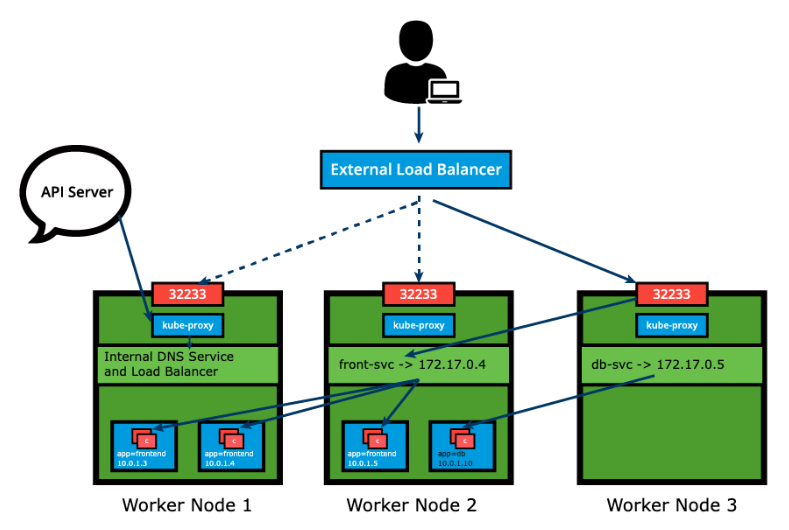
The LoadBalancer ServiceType will only work if the underlying infrastructure supports the automatic creation of Load Balancers and have the respective support in Kubernetes, as is the case with the Google Cloud Platform and AWS. If no such feature is configured, the LoadBalancer IP address field is not populated, it remains in Pending state, but the Service will still work as a typical NodePort type Service.
ExternalIP
Section titled “ExternalIP”A Service can be mapped to an ExternalIP address if it can route to one or more of the worker nodes. Traffic that is ingressed into the cluster with the ExternalIP (as destination IP) on the Service port, gets routed to one of the Service endpoints. This type of service requires an external cloud provider such as Google Cloud Platform or AWS and a Load Balancer configured on the cloud provider’s infrastructure.
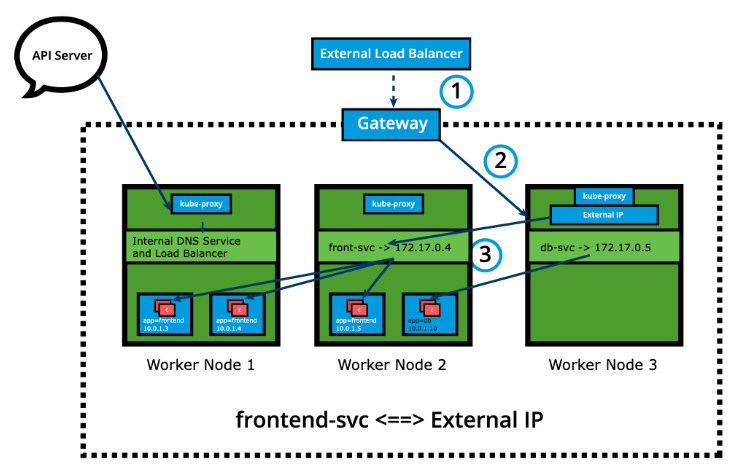
Please note that ExternalIPs are not managed by Kubernetes. The cluster administrator has to configure the routing which maps the ExternalIP address to one of the nodes.
ExternalName
Section titled “ExternalName”ExternalName is a special ServiceType that has no Selectors and does not define any endpoints. When accessed within the cluster, it returns a CNAME record of an externally configured Service.
The primary use case of this ServiceType is to make externally configured Services like my-database.example.com available to applications inside the cluster. If the externally defined Service resides within the same Namespace, using just the name my-database would make it available to other applications and Services within that same Namespace.
Multi-Port Services
Section titled “Multi-Port Services”A Service resource can expose multiple ports at the same time if required. Its configuration is flexible enough to allow for multiple groupings of ports to be defined in the manifest. This is a helpful feature when exposing Pods with one container listening on more than one port, or when exposing Pods with multiple containers listening on one or more ports.
A multi-port Service manifest is provided below:
apiVersion: v1kind: Servicemetadata: name: my-servicespec: selector: app: myapp type: NodePort ports: - name: http protocol: TCP port: 8080 targetPort: 80 nodePort: 31080 - name: https protocol: TCP port: 8443 targetPort: 443 nodePort: 31443The my-service Service resource exposes Pods labeled app==myapp with possibly one container listening on ports 80 and 443, as described by the two targetPort fields. The Service will be visible inside the cluster on its ClusterIP and ports 8080 and 8443 as described by the two port fields, and it will also be accessible to incoming requests from outside the cluster on the two nodePort fields 31080 and 31443. When manifests describe multiple ports, they need to be named as well, for clarity, as described by the two spec.port.name fields with values http and https respectively. This Service is configured to capture traffic on ports 8080 and 8443 from within the cluster, or on ports 31080 and 31443 from outside the cluster, and forward that traffic to the ports 80 and 443 respectively of the Pods running the container.
Port Forwarding
Section titled “Port Forwarding”Another application exposure mechanism in Kubernetes is port forwarding. In Kubernetes the port forwarding feature allows users to easily forward a local port to an application port. Thanks to its flexibility, the application port can be a Pod container port, a Service port, and even a Deployment container port (from its Pod template). This allows users to test and debug their application running in a remote cluster by targeting a port on their local workstation (either http://localhost:port or http://127.0.0.1:port), a solution for remote cloud clusters or virtualized on premises clusters.
Port forwarding can be utilized as an alternative to the NodePort Service type because it does not require knowledge of the public IP address of the Kubernetes Node. As long as there are no firewalls blocking access to the desired local workstation port, such as 8080 in the examples below, the port forwarding method can quickly allow access to the application running in the cluster.
Based on the earlier explored frontend Deployment and frontend-svc Service, port forwarding can be easily achieved via one of the following methods:
kubectl port-forward deploy/frontend 8080:5000kubectl port-forward frontend-77cbdf6f79-qsdts 8080:5000kubectl port-forward svc/frontend-svc 8080:80All three commands forward port 8080 of the local workstation to the container port 5000 of the Deployment and Pod respectively, and to the Service port 80. While the Pod resource type is implicit, therefore optional and can be omitted, the Deployment and Service resource types are required to be explicitly supplied in the presented syntax.